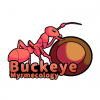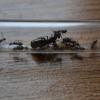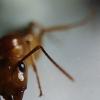Camponotus chromaiodes Queens
I've managed to collect two more queens during flights, and all 4 of the queens I've collected now have eggs. Due to the cooler temperature that will be occurring during the next few days, I don't believe they'll fly again until Wednesday, the night after some heavy rains and storms that will be rolling through on Tuesday, and I believe other species will be flying on Wednesday too. Stay tuned for updates.
Crematogaster minutissima Colony C
I've collected a third colony from within a hickory nut buried in the leaf litter. The colony contains 4 dealates, around 60 workers and a small amount of young brood, mostly L1 larvae.
Nylanderia cf. vividula
Once again from a buried hickory nut comes a very large colony of Nylanderia cf. vividula! The colony contains a single dealate, about 10 alate females, over 150 workers and a large amount of brood. I currently have them in a test tube setup, but they will have to be moved into something a bit larger, as currently feeding will be nearly impossible without a whole bunch of workers getting out. I'll probably move them into one of my lab-style setups, similar to the test tube-based formicarium my Tapinoma sessile colony is currently nesting in.
Camponotus castaneus Colony A
There is no way this colony was ready for such a large formicarium, and I will be moving them back into a test tube setup until the year's first workers eclose in late May. They're not doing bad or anything, I just need to free up some space, as I plan to move my Pheidole crassicornis into the formicarium they are currently nesting in, as they do not seem to like how moist their current formicarium is.
Camponotus castaneus Colony B
Still no eggs and the queen is still really thin. I'm starting to get worried about how they're doing, as all of my other castaneus colonies have come out of hibernation and now have eggs. Maybe the formicarium just isn't warm enough. I will be attempting to warm the formicarium, but I'm not exactly sure how. They're not really eating anything either. The only good thing is that no worker in this colony has died since their collection in October, but no new workers have been produced either. I may try and brood boost them with some wild larvae and see how they do with that.
Tapinoma sessile Colony B
From the same area Colony A was collected and from another hickory nut comes a founding colony with a single queen, 10-15 workers, and a decent amount of brood for the colony's size.
Temnothorax curvispinosus Colonies
I've collected a whole bunch of Temnothorax curvispinosus colonies, 3 with queens and 2 without. I have some really cool plans for the queenless colonies, and for those of you who know a fair bit about the biology of this very interesting species, you probably know what experiments I have in mind, but it involves worker reproduction and a bit of incest (though not really, as male ants are genetically unrelated to their siblings in most cases including with this species).
And now for the big finale of this very special journal entry...
Trachymyrmex septentrionalis
I've finally managed to find a very large population of this species, and I have very easy access to them too! I only collected a single colony though, as collecting this one very large colony took me two hours. The colony had 4 chambers, but the 2nd chamber was the largest. The queen was actually in the first chamber, which was the last chamber I found. The colony is monogynous (as most large colonies are) with around 400 workers, no brood, and a very small amount of fungus, which is to be expected, as colonies only just came out of hibernation. In the area I found this colony, there were about 20 more in the same immediate area, one very large and active one that was right beside this one. I put one of each colony's workers beside each other though and they fought. They were definitely not related, which is odd, as the colonies were only about a foot apart. The area also had many colonies of Dorymyrmex bureni, Nylanderia sp. (presumably vividula or concina), Lasius neoniger, and Pheidole bicarinata & dentata. And the great part about it is that whenever I need colonies of any of those species (I'll definitely need more Trachymyrmex), I'll have easy access to them. I managed to keep the Trachymyrmex alive for several hour in a pill bottle with a cotton ball and soil from their collection area while I went fishing and some more collecting, and very few deaths occurred, around 10 due to me handling the individual ants too roughly. I moved the colony into an Attine-style lab formicarium with two chambers as opposed to the usual one chamber I keep my Cyphomyrmex in. As of yet, I see very little fungus, but knowing Trachymyrmex, that fungus will grow very quickly. However, if it doesn't I always have access to more of it.




















